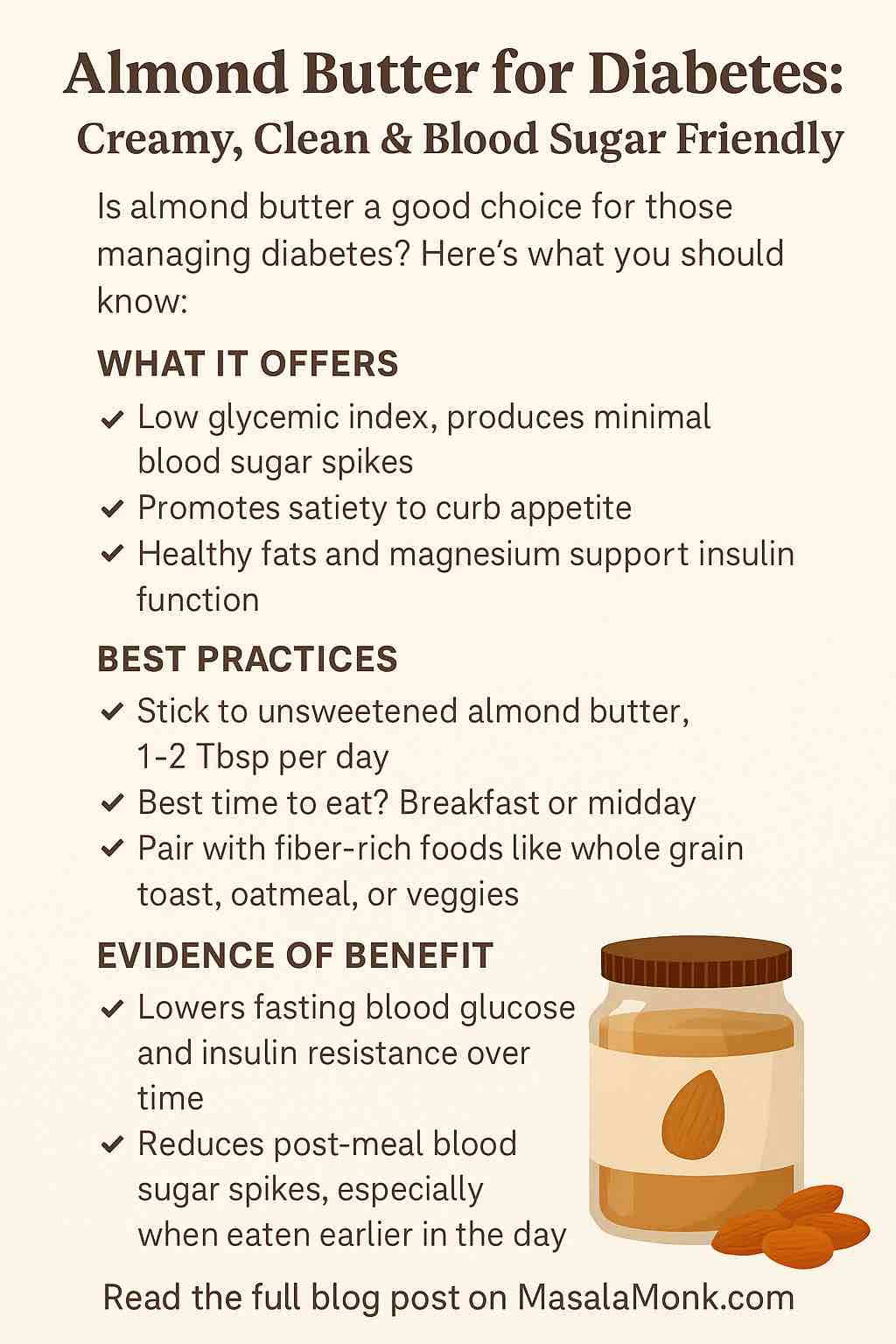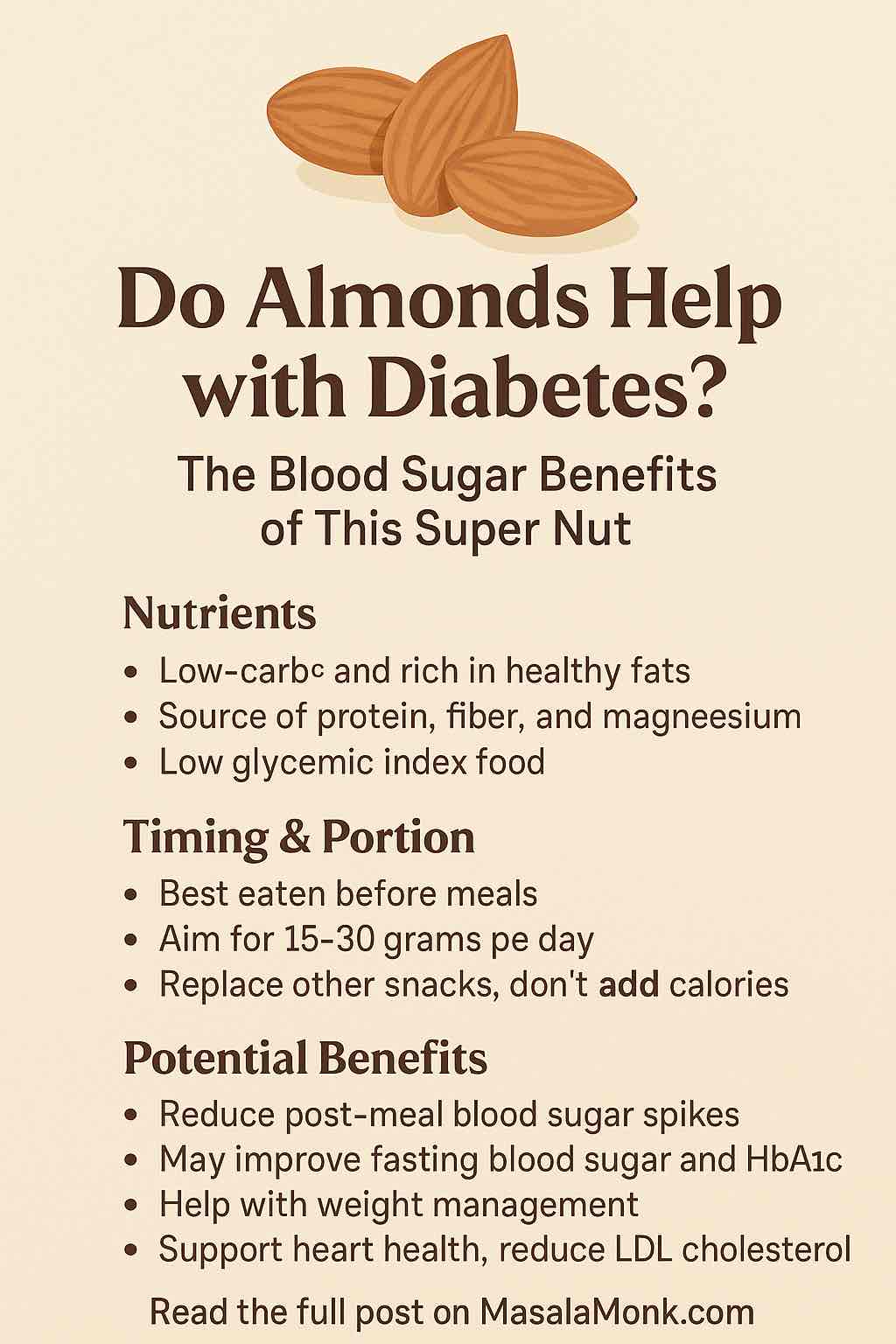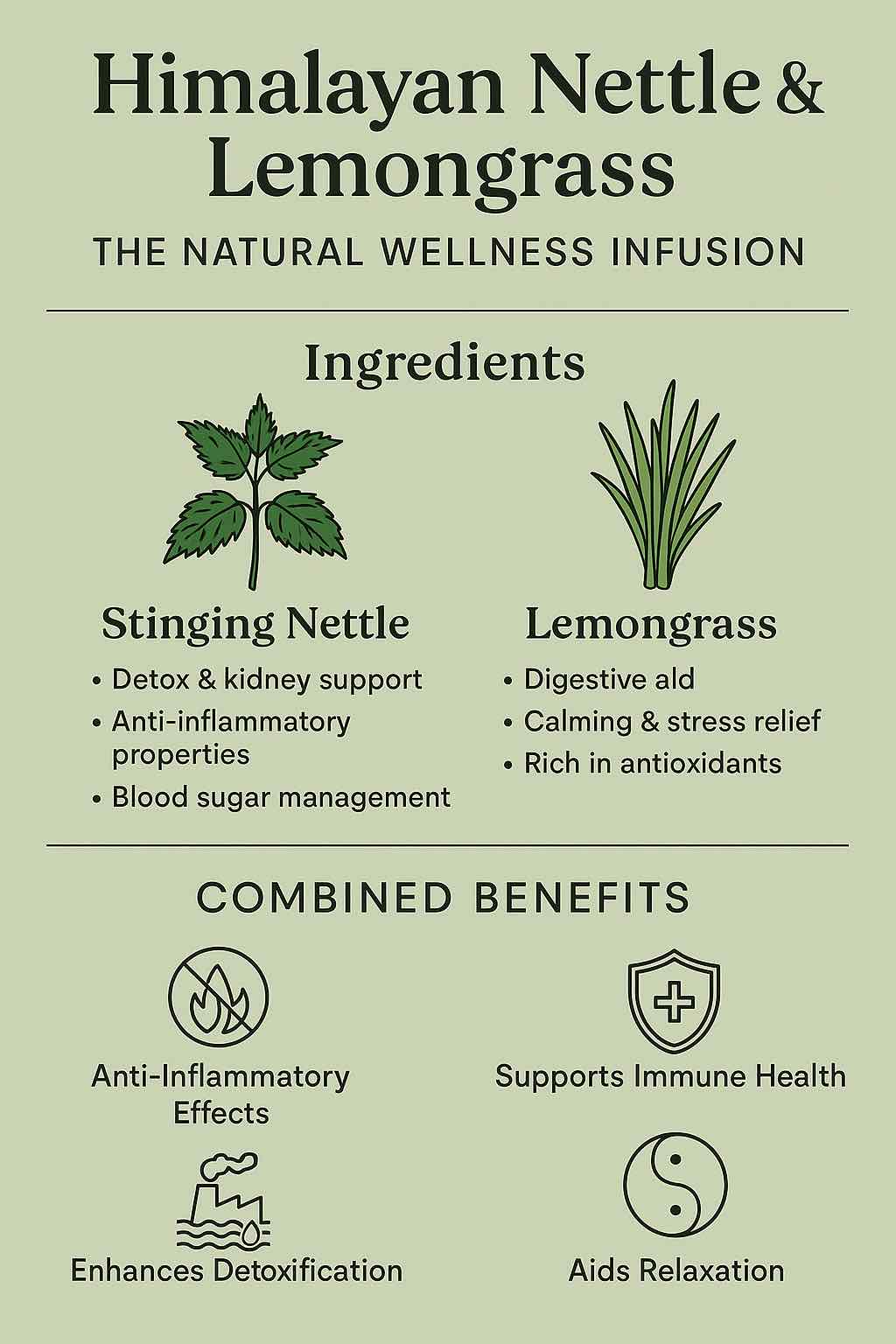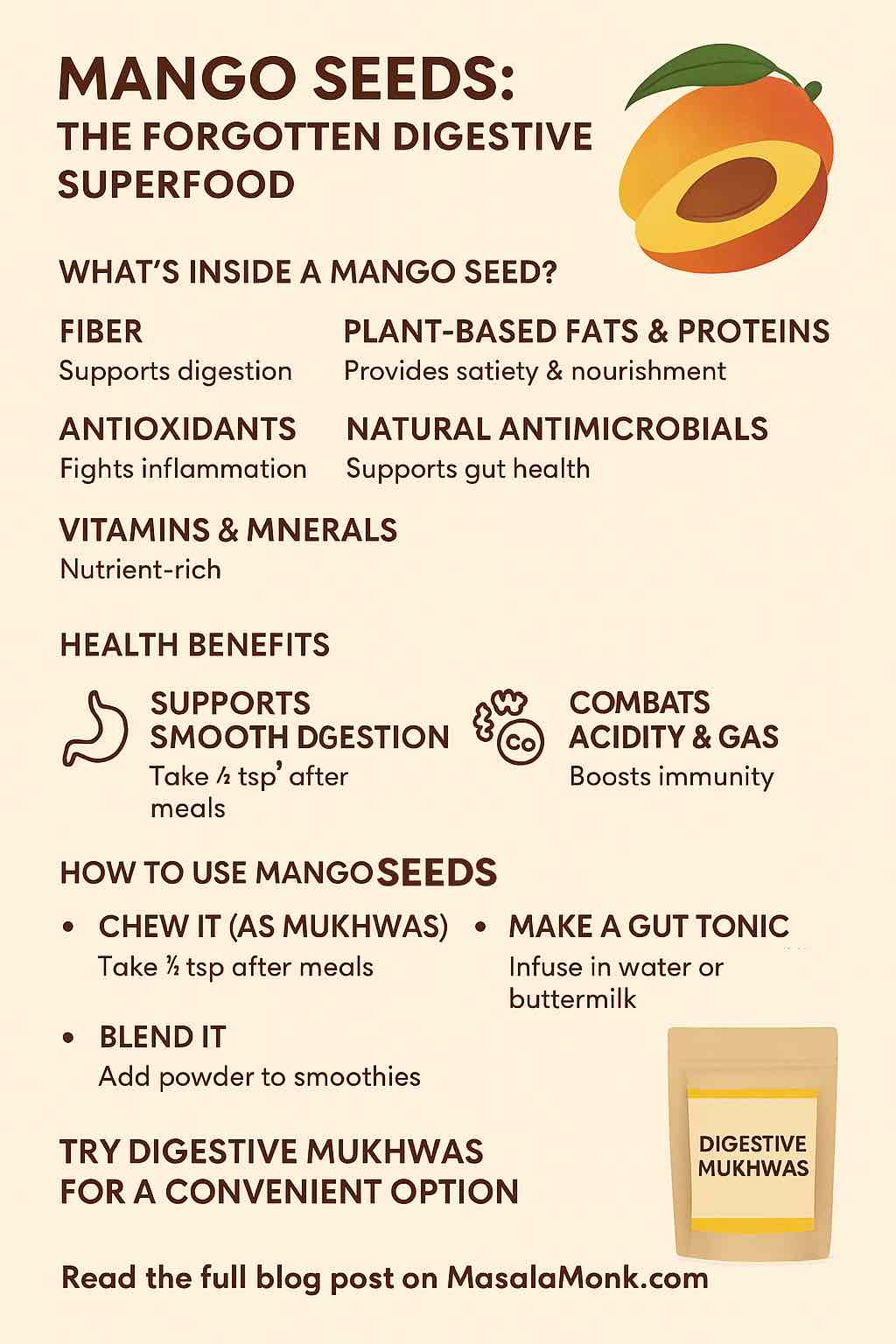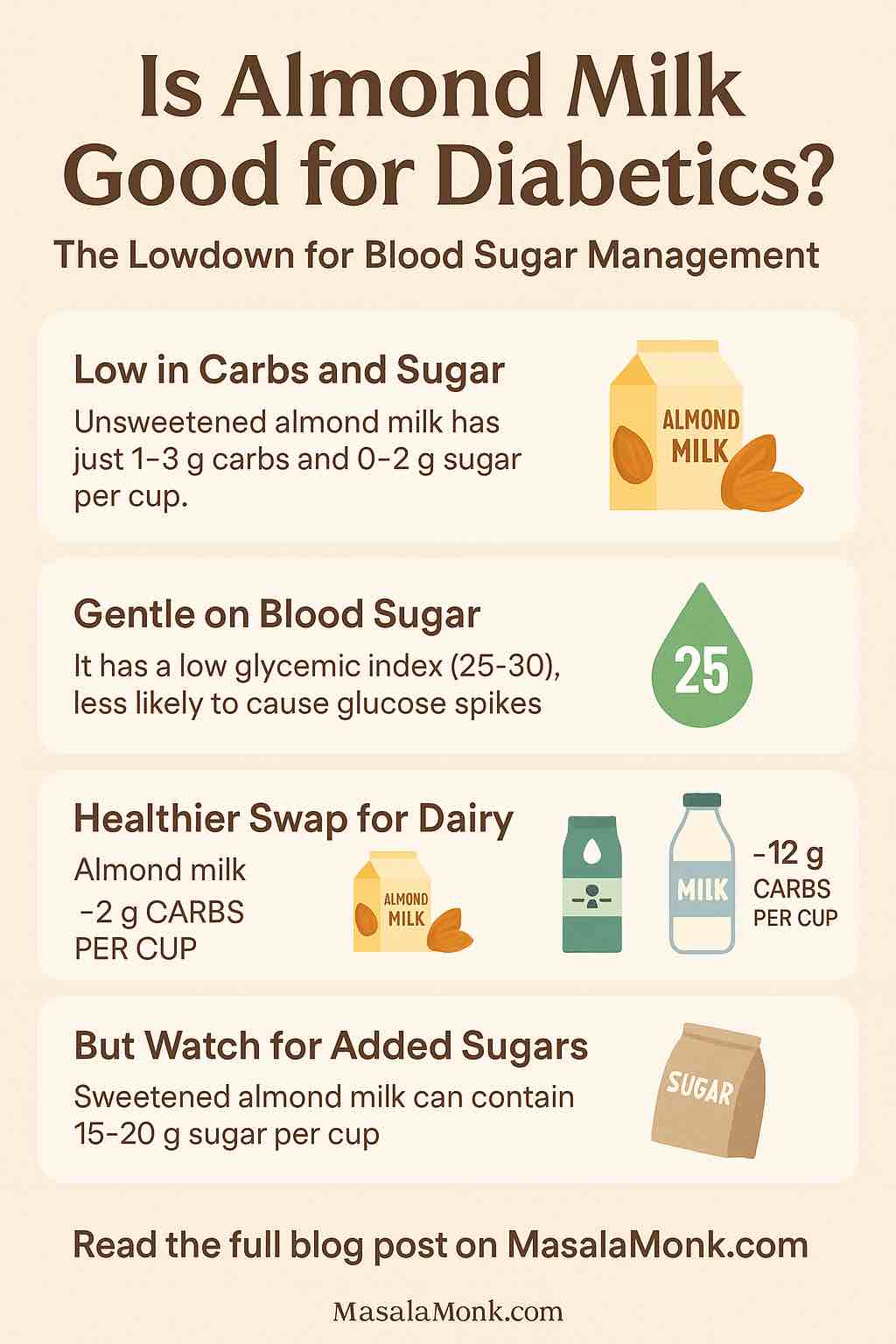
For people managing diabetes, every sip counts—especially when it comes to milk and milk alternatives. If you’re wondering whether almond milk is a smart swap for your chai, smoothie, or cereal bowl, the answer is: yes, but it depends on the type.
Almond milk is low in carbs, naturally lactose-free, and—when unsweetened—offers a creamy, blood-sugar-friendly alternative to dairy. But as with most things in nutrition, the devil is in the details.
Let’s explore the latest science, practical tips, and smart ways to use almond milk to help manage blood sugar and support your overall health.
🧬 Why Almond Milk is Diabetic-Friendly
Here’s a quick comparison of unsweetened almond milk versus traditional cow’s milk:
| Nutrient (per 1 cup) | Unsweetened Almond Milk | 2% Cow’s Milk |
|---|---|---|
| Calories | ~35–40 kcal | ~120 kcal |
| Carbs | 1–3 g | ~12 g |
| Sugars | 0–2 g | ~12 g (natural lactose) |
| Protein | 1 g | 8 g |
| Fat | 2.5–3 g (mostly MUFA) | 5 g (some saturated) |
| GI (Glycemic Index) | ~25–30 | ~47–55 |
📌 Key takeaway: Almond milk is lower in calories, carbs, and sugars than cow’s milk—ideal for managing blood sugar.
🔬 What Research Says: Almond Milk vs Cow’s Milk
✅ Latest Study (2025, RCT in T2D Patients)
Researchers gave adults with type 2 diabetes almond milk or cow’s milk matched for calories or carbs, alongside oatmeal.
Result:
- Similar blood glucose curves in both groups.
- However, cow’s milk caused higher insulin and glucagon levels, meaning more demand on the pancreas.
📌 Almond milk provided a more insulin-sparing effect, helpful for those with insulin resistance.
🧠 Additional Benefits of Almond Milk for Diabetics
1. Low Glycemic Impact
- Unsweetened almond milk has a glycemic index of ~25, well below the threshold that causes sharp glucose spikes.
- Sweetened versions? That’s a different story.
2. Heart Health Support
- Rich in monounsaturated fats (MUFA) and vitamin E, almond milk may help reduce LDL cholesterol and inflammation—both key concerns for diabetics.
3. Fortification Benefits
Most almond milks are fortified with:
- Calcium – for bone strength
- Vitamin D – supports insulin sensitivity
- Vitamin E – antioxidant; supports heart and skin health
⚠️ What to Watch Out For
❌ 1. Sweetened and Flavored Varieties
Some almond milk brands add up to 20 grams of sugar per cup—a blood sugar disaster.
🔍 Look for labels that say:
- “Unsweetened”
- “No added sugars”
- “0g added sugar”
❌ 2. Low Protein Content
While almond milk is light on sugar, it’s also light on protein (~1g/cup). If you’re using it as a milk substitute, make sure to pair it with protein-rich foods:
✅ Try pairing with:
- Greek yogurt
- Eggs
- Nut butter toast
- Protein smoothies
❌ 3. Gum & Additive Sensitivity
Some people may be sensitive to gums or stabilizers (e.g., carrageenan) found in commercial almond milk. Choose clean-label brands with minimal ingredients.
🛠️ How to Use Almond Milk in a Diabetes-Friendly Diet
☕ 1. In Your Tea or Coffee
Unsweetened almond milk works great in:
- Black tea
- Green tea
- Herbal blends
- Coffee (froths well too!)
🥣 2. In Smoothies
A low-carb base that blends well with:
- Leafy greens
- Berries (low-GI)
- Nut butter or seeds
- Unsweetened protein powders
🍚 3. With Oats or Chia Pudding
Almond milk adds creaminess without the carb load of dairy.
🍲 4. In Cooking
Use it in place of dairy milk in:
- Curries
- Soups
- Healthy desserts
🧾 Pro Tips for Smart Almond Milk Use
- ✅ Always buy unsweetened
- ✅ Check for fortification with calcium, D, and E
- ✅ Pair with protein for balanced meals
- ✅ Use in place of, not in addition to, other milks
- ✅ Test your blood sugar when trying new brands or recipes
✅ Final Takeaways
| ✅ What’s Great | ⚠️ What to Avoid |
|---|---|
| Low in carbs and sugar | Sweetened/flavored varieties |
| Low glycemic index | Brands with gums/additives |
| Fortified with nutrients | Thinking it replaces protein |
| Good in smoothies and chai | Overconsumption (empty cals) |
💬 So, Is Almond Milk Good for Diabetics?
Yes—especially if it’s unsweetened and used strategically.
It’s a low-carb, low-calorie, blood-sugar-friendly option that can support your diabetes journey. Just remember: read labels, pair wisely, and don’t forget the protein.
🔗 Related Reads: Almonds in All Forms for Blood Sugar Control
If almond milk caught your attention, you’ll love learning about its equally powerful siblings:
🥜 Whole Almonds: The Blood Sugar Buffer
In our first post, we explored how eating raw almonds before meals can reduce post-meal glucose spikes, improve insulin response, and even support satiety.
🔗 Read here: Do Almonds Help with Diabetes?
🥄 Almond Butter: Creamy, Clean, and Diabetes-Friendly
Almond butter brings the same benefits—packed in a spreadable form. Especially effective when eaten at breakfast or with fiber-rich meals.
🔗 Read here: Almond Butter for Diabetes
Together, these almond-based foods offer a powerful toolkit for blood sugar management, from snacks to smoothies to sips. 🌿
❓ 10 FAQs: Almond Milk and Diabetes
1. Is almond milk safe for diabetics?
Yes, especially unsweetened almond milk. It has low carbohydrates, no added sugar, and a low glycemic index—making it ideal for blood sugar control.
2. Does almond milk raise blood sugar?
Unsweetened almond milk does not significantly raise blood sugar due to its low glycemic load. However, sweetened varieties can spike glucose levels.
3. Which is better for diabetics: almond milk or cow’s milk?
Almond milk is lower in carbs and sugars, making it better for those watching their blood sugar. Cow’s milk contains natural lactose (sugar), which may affect glucose more strongly.
4. Can almond milk replace regular milk in all recipes?
Yes, almond milk works well in smoothies, chai, oats, baking, and curries. Just keep in mind it is lower in protein, so consider adding a protein source.
5. What should I look for on almond milk labels?
Choose options labeled:
- “Unsweetened”
- “No added sugar”
- Fortified with calcium, vitamin D, and vitamin E
6. How much almond milk can a diabetic drink per day?
Most people can enjoy 1–2 cups daily as part of a balanced diet. Always monitor your individual response, especially when combining with other carbs.
7. Is almond milk OK for type 2 diabetes?
Yes. In fact, studies show almond milk produces lower insulin demand than cow’s milk and can support better glycemic balance in people with type 2 diabetes.
8. What’s the best time to drink almond milk?
Any time, but it’s especially useful:
- In the morning for smoothies or oats
- As a snack base
- Before or after workouts when paired with protein
9. Can almond milk help with weight management?
Yes. It’s low in calories and promotes fullness when combined with other healthy fats and proteins—helpful for weight control in diabetes management.
10. Can I make almond milk at home for diabetes?
Absolutely! Homemade almond milk can be 100% free of added sugar and additives. Use soaked almonds, blend with water, and strain. Flavor with cinnamon or vanilla (no sugar).

